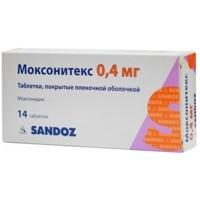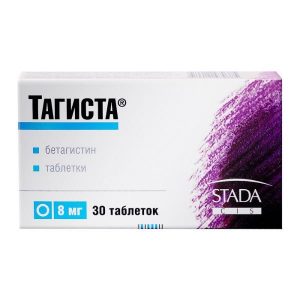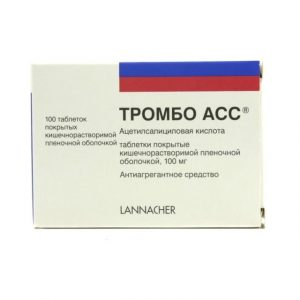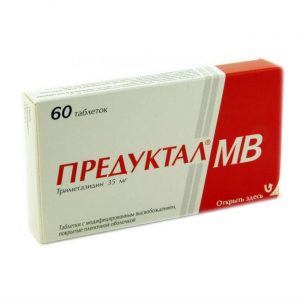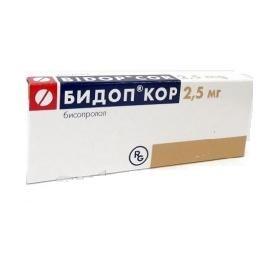Description
Latin name
MOXONITEX
Release form
Film-coated tablets, light pink, round, biconvex.
Pharmacological action of
Selective imidazoline receptor agonist. Antihypertensive drug
Indications
– arterial hypertension.
Contraindications
– angioedema in the anamnesis of
– SSS or sinoatrial blockade
– AV block II and III degree
– severe bradycardia (less than 50 beats / min at rest)
heart failure – III-IV functional class according to NYHA classification)
– unstable angina pectoris
– severe hepatic insufficiency
– severe renal failure (CC less than 30 ml / min, serum creatinine content – more than 160 Ñmol / l)
– age up to 18 years
– lactation period
– galactose intolerance, lactase deficiency or glucose-galactose malabsorption syndrome
– hypersensitivity to moxonidine or any other component of the drug.
With caution and under the supervision of a physician, the drug should be used in patients after a recent myocardial infarction or in cases of peripheral circulatory disorders (intermittent claudication, Raynaud’s syndrome) in patients with moderate renal impairment (CC 30-60 ml / min. Serum creatinine 105- 160 Ñmol / l), with impaired liver function, during pregnancy, depression, glaucoma, epilepsy, Parkinson’s disease.
Use during pregnancy and lactation
There is no clinical evidence of a negative effect on pregnancy. However, Moxonitex should be prescribed during pregnancy only if if the potential benefit of therapy for the mother outweighs the potential risk to the fetus.
Moxonidine is excreted in breast milk. If it is necessary to use the drug during lactation, breastfeeding should be discontinued.
Special instructions
During treatment, regular monitoring of blood pressure, heart rate and ECG is required.
If necessary, the cancellation of simultaneously taken beta-blockers and Moxonitex are the first to cancel beta-blockers and only after a few days – Moxonitex. Moxonitex should be discontinued gradually.
Effect on the ability to drive vehicles and control mechanisms
The effect of the drug Moxonitex on the ability to drive vehicles or drive vehicles has not been studied. Taking into account the possible occurrence of dizziness and drowsiness, patients should be careful when engaging in potentially hazardous activities, such as driving vehicles or driving machinery that require an increased concentration of attention.
Composition
1 tab.
moxonidine 200 mcg
Excipients: lactose monohydrate – 94.5 mg, povidone K25 – 2 mg, crospovidone – 3 mg, magnesium stearate – 0.3 mg.
Composition of the film coat: opadry Y 1 7000 – 3.498 mg (titanium dioxide – 1.093 mg, hypromellose – 2.186 mg, macrogol 400 – 0.219 mg), iron dye red oxide – 0.002 mg.
Dosage and administration
Moxonitex is prescribed orally, regardless of food intake, with plenty of fluids. The dosage regimen is selected individually.
Initial dose is 200 mcg in the morning. With insufficient therapeutic effect, the dose after 3 weeks is increased to 400 mcg / day once or in 2 divided doses. The maximum daily dose is 600 mcg, the maximum single dose is 400 mcg.
In patients with moderate impaired renal function (CC 30-60 ml / min), a single dose should not exceed 200 mcg, the maximum daily dose is 400 mcg.
Side effects
Determination of the frequency of adverse reactions: often (? 1%), rarely (0.01% -0.1%), sometimes (<0.01%, isolated cases). From the cardiovascular system: rarely – symptoms of vasodilation, sometimes – a pronounced decrease in blood pressure, syncope, Raynaud’s syndrome, peripheral edema. From the side of the central nervous system: often – dizziness, headache, drowsiness, fatigue, sleep disturbance, sometimes – paresthesia, depression, anxiety. From the digestive system: often – dry oral mucosa, nausea, anorexia, constipation. From the genitourinary system: sometimes – retention or urinary incontinence, impotence and / or decreased libido. From the sensory organ: sometimes – dry eyes, causing itching or burning sensation. Allergic reactions: sometimes – urticaria, pruritus, exanthema, angioedema. Other: sometimes – gynecomastia, soreness of the parotid glands. Drug interaction When co-administration of moxonidine with other antihypertensive drugs, a mutual increase in action occurs. Beta-blockers increase bradycardia, the severity of the negative foreign and dromotropic effects. Moxonidine enhances the hypotensive effect of ethanol, sedatives, slow calcium channel blockers (derivatives of dihydropyridine). Moxonidine should not be used concurrently with tricyclic antidepressants. Tolazolin dose-dependently reduces the hypotensive effect of moxonidine. Overdose Symptoms: headache, severe BP, bradycardia, palpitations, weakness, drowsiness, dryness of the mucous membrane of the oral cavity is rare – vomiting and pain in the epigastrium. Paradoxical arterial hypertension and hyperglycemia are potentially possible. Treatment: symptomatic. There is no specific antidote. In case of marked decrease in blood pressure, it is recommended to restore BCC due to the introduction of fluid. -Adrenoreceptor antagonists are capable of reducing or eliminating transient arterial hypertension when overdosed with moxonidine. Storage Conditions List B. The preparation should be stored out of the reach of children at a temperature not exceeding 25 ° C. Shelf life 2 years Deystvuyushtee substance Moxonidine Terms and conditions prescription dosage form tablets Possible product names moxonitex tablet coated 200 mcg 14 pcs. Sandoz, Switzerland
